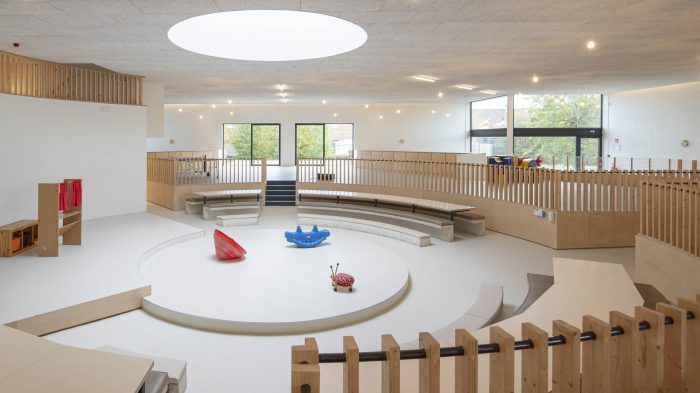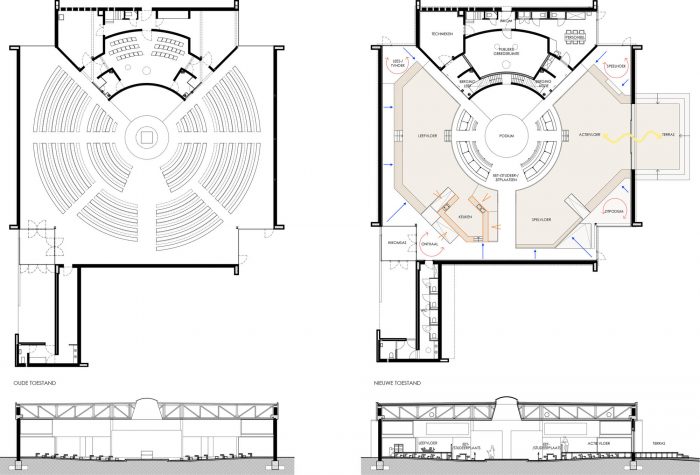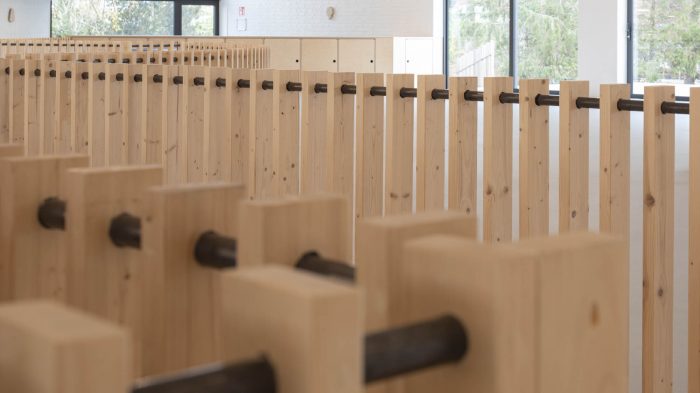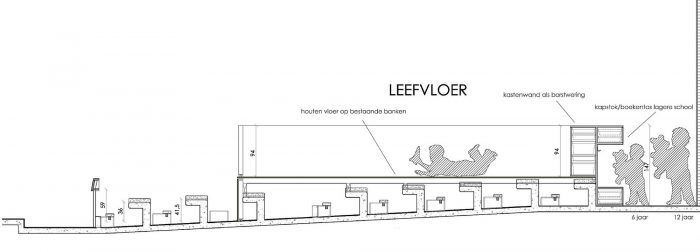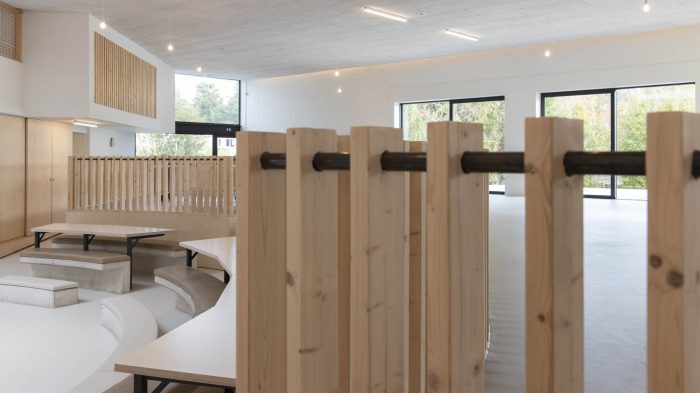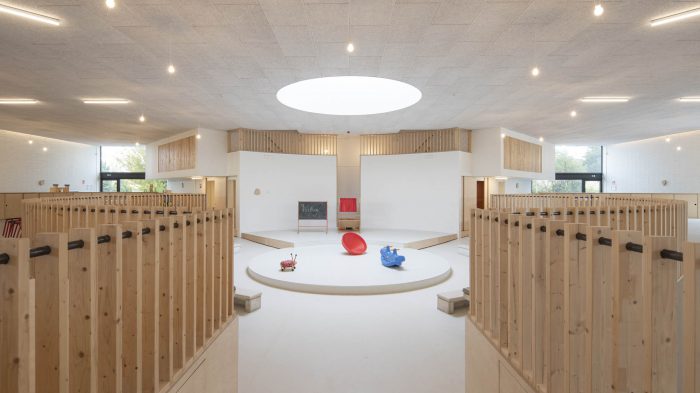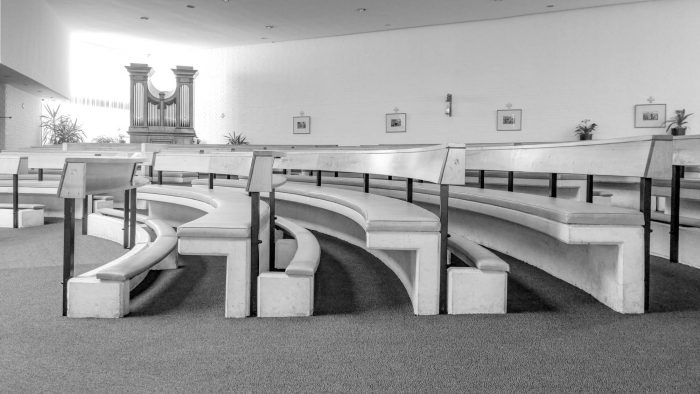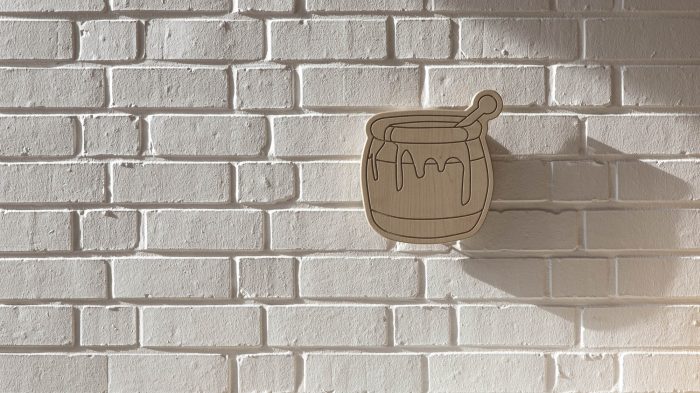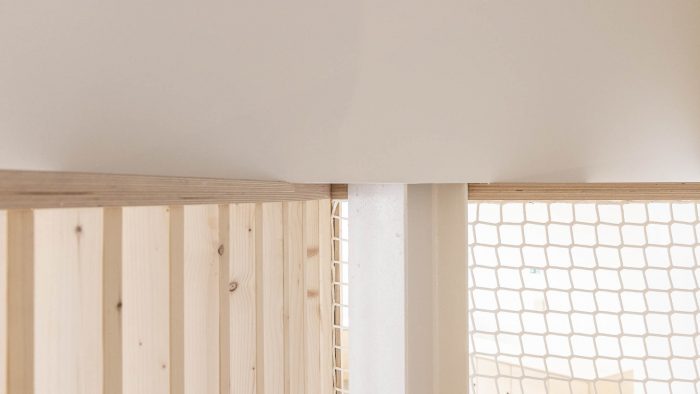由于定义明确的重建食谱并不奏效,因此,定制化是文物保护的根本,埃克洛市组织了一场竞赛,以确保其计划中的从教堂建筑到校外托儿所的重新改造顺利进行。至少可以说是:”一个挑战!
过去圣约瑟夫教堂内和周围很安静,现在孩子们会乐在其中。使用方式将从周末转移到一周,以及需要相当不同的流动性。过去教堂的信徒在做弥撒时都会穿上厚厚的外套,而现在穿着短裤的幼儿很快就会在地板上爬行。
Because well-defined redevelopment recipes don’t work and therefore, customization is fundamental in heritage conservation, the City of Eeklo organized a competition to ensure that its planned reconversion from the church building to out-of-school childcare runs smoothly. To say the least: ‘a challenge!
Where it used to be quiet in and around the Sint Joseph church, children would now enjoy themselves. The use would shift from the weekend to the week, as well as entail quite a different mobility. Where churchgoers used to wear a thick coat during mass, toddlers in shorts will soon be crawling across the floor.
建筑空间性、儿童友好性、循环方式、活力提升、无障碍性和双重用途,将项目提升为一个典范项目。我们只是 “客人”。由于新的功能是一个可能会随着时间推移而演变的迫切需求的结果,之前的城市建筑师Filip De Pau认为,通过硬性、昂贵的干预措施来永久改变建筑是不负责任的。因此,竞赛规范刺激了可逆的干预。我们只是 “客人”。
The architectural spatiality, the child-friendliness, the circular approach, the energetic upgrading, the accessibility, and the double use elevate the project to an exemplary project. We are only “guests”. Because the new function is the result of an acute need that may evolve over time, the previous city architect Filip De Pau considered it irresponsible to permanently change the building through hard, expensive interventions. The competition specifications, therefore, stimulated a reversible intervention. We are only “guests”.
现有教堂的特点是一个大的矩形空间,没有中庭。环形的平面图围绕着祭坛,配以一排排上升的长椅和圆顶冠,唤起了一种神圣的感觉。礼仪是在一个中央平台上进行的,所有的座位都指向这个平台。这些元素中有许多可以 “复原 “并作为一种资产使用。改造尊重了现有的规划组织,围绕着一个中心,通过天顶的日光注入来强调。前两排银行的功能被留下。它们将孩子们团结在一个讲故事的时刻或木偶戏周围。
监测了视觉可读性和空间效果。避免了高墙、柜子或会使空间崩塌或分割的体积。倾斜的地面和混凝土长椅也被保留下来。为了创造新的生活和运动地板,它们被覆盖在木质结构上,可以随时拆除。循环性是最好的!
The existing church was characterized by one large rectangular space, without naves. The circular floor plan organized around the altar, with ascending rows of benches and dome crowns, evoked a sacred dimension. The liturgy was celebrated on a central plateau, to which all seats were directed. Many of these elements could be “recovered” and used as an asset. The conversion respects the existing planning organization, around a center, accentuated by a zenithal daylight injection. The first two bank rows are left in function. They unite the children around a storytelling moment or puppet theater.
The visual readability and spatial effect were monitored. High walls, cabinets, or volumes that would crumble or divide the space were avoided. The sloping floor and the concrete benches have also been retained. To create the new living and exercise floors, they were covered with a wooden structure, which can be removed at any time. Circularity at its best!
长椅之间明显不再使用的空间被百叶窗横向接入,并作为存储空间。其中,以前的长椅扶手和书架被保留了下来。该设计一方面在历史和建筑价值与新需求之间找到了新的平衡点。
功能性。孩子们比以往任何时候都更需要一个温暖的小窝,一个休息的地方,同时也需要一个能邀请行动、探索和发展个人能力的地方。由于经典的高大的独立墙柜难以与建筑协调,而所需的扶手是沿着环形走廊设计成背靠背的柜子;一方面可以从走廊和角落进入,另一方面可以从生活层和运动层进入。柜子和扶手的双重功能使得节省材料成为可能。结果看起来清新而现代。它说明了转换的力量。次要房间(会议室、圣器室……)被改造成了学习、睡眠或工艺空间。宽大的坡面是根据每个人的无障碍性而建造的(轮椅使用,但也包括带婴儿车的父母)。
The apparently no longer usable space between the benches was made laterally accessible by means of shutters and serves as storage space. Among other things, the former bench handrails with bookshelf are preserved there. The design finds a new balance between historical and architectural values on the one hand and new needs on the other.
Functional. More than ever before, children need a warm nest, a place of rest, but also a place that invites action, exploration, and the development of personal competencies. Because classic, high, free-standing wall cabinets were difficult to reconcile with the architecture and the required handrail was worked out along the circular hallway as a back-to-back cabinet; accessible on the one hand from the hallway and corners, on the other hand from the living and exercise floors. The dual function of the cabinet and handrail made it possible to save on material. The result looks fresh and contemporary. It illustrates the power of conversion. The secondary rooms (meeting rooms, sacristy,…) have been transformed into study, sleeping, or craft space. Wide sloping surfaces have been constructed based on accessibility for everyone (wheelchair use, but also parents with a buggy).
技术上的。由于在历史建筑中,从技术角度(隔热、玻璃/木工等)减少与建筑相关的需求不能像在新建筑中那样继续,因此必须更有效地处理其他选择(隔断、与安装相关的需求减少、有效的发热…)。此外,有必要处理这样一个事实,即教堂转为校外儿童保育也需要其他(标准)要求。这包括,除其他外,提高舒适温度、通风率和勒克斯水平。意识到即使是新的装置也会比建筑本身的寿命短,因此特别注意了维护、修理、更换或处理的可能性。为了保护遗产,这必须在不造成损害的情况下进行。
Technical. Due to the fact that in historical buildings the reduction of the needs related to the building from a technical point of view (insulation, type of glazing/joinery, etc.) cannot be continued as far as in new construction, the other options had to be dealt with all the more efficiently (compartmentalisation, installation-related demand reduction, efficient generation of heat, …). Moreover, it was necessary to deal with the fact that the conversion of the church to out-of-school childcare also entailed other (standard) requirements. This includes, among other things, increased comfort temperatures, ventilation rates, and lux levels. Realizing that even the new installations would sustain a shorter life than the building itself, special attention was paid to the possibilities for maintenance, repair, replacement, or disposal. In respect of the heritage, this must be possible without consequential damage.
中央教堂的大空间没有承重隔墙也没有柱子。金属屋梁做了跨度。由于下面的天花板,从教堂里看不到这些梁。在改造过程中,通风管道使用了现有的天井。考虑到地暖在技术上的不可行性和散热器在遗产上的不兼容性,这些通道也负责供热。由于BaOpt的调整,没有恼人的方向性,而是弥漫的柔和气流。
鉴于建筑的高热惯性,大风量,以及朝南的窗户的测量量,过热是没有风险的。由于出于安全考虑,必须安装新的防火天花板,结果声学效果突然得到改善,照明问题也得到解决。
The large space of the central church has no load-bearing dividing walls neither columns. Metal roofbeams make the span. Due to an underlying ceiling, these were not visible from the church. During the reconversion, the existing plenum was used for the ventilation ducts. Given the technical impracticability of underfloor heating and the heritage incompatibility of radiators, these channels are also responsible for the heat supply. Thanks to the BaOpt adjustment, there are no annoying directional, but diffuse soft airflows.
Given the high thermal inertia of the construction, the large air volume, and the measured amount of windows facing south, overheating is not a risk. As a new fire-resistant ceiling had to be installed for safety reasons, as result the acoustics were suddenly improved and the lighting was also addressed.
可持续发展。埃克洛市确认了市长公约,并承诺到2030年减少40%的温室气体排放。竞争规范将这一目标又紧缩了10年。遗产的保温被视为一个跨学科的声明,其中文化价值、建筑物理学、历史材料和结构必须结合起来。对外墙进行了保温,给屋顶戴上了暖帽,并将外墙的细木工板换成了高质量的热工板。
Sustainable. The city of Eeklo confirmed to the Covenant of Mayors and promised to emit 40% fewer greenhouse gases by 2030. The competition specifications tightened that goal for another 10 years. The thermal insulation of the heritage was approached as an interdisciplinary statement in which cultural values, building physics, historical materials, and constructions had to operate in conjunction. The exterior walls were insulated, the roof was given a warm cap and the exterior joinery was replaced by a high-quality thermal version.
建筑物进行了 “重新照明”,采用热回收和BaOpt控制的平衡通风,热泵供暖和可再生能源生产的光伏装置。为了满足更高的卫生消耗,提供了额外的雨水收集和回收功能。部分由于循环理念,材料的使用受到限制。该建筑仔细审视其新的未来。使用是以当地为导向的,这鼓励了温和的流动性。与利益相关者协调了一个参与过程。空间的双重使用已经提上日程。
The building was given a “relighting”, balanced ventilation with heat recovery and BaOpt control, a heat pump heating and a PV installation for renewable energy production. In function of higher sanitary consumption, additional rainwater collection and recovery were provided. Partly due to a circular philosophy, the use of materials was limited. The building looks carefully at its new future. The use is locally orientated, which encourages gentle mobility. A participation process was coordinated with the stakeholders. Double use of the spaces is already on the agenda.
建筑师:Denc!-studio
年份:2020年
制造商:BaOpt
城市:Eeklo
国家:比利时
Architects: denc!-studio
Year: 2020
Manufacturers: BaOpt
City:Eeklo
Country:Belgium


